Three Les Pauls
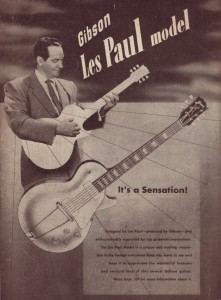
A couple weeks ago, my birthday rolled around, and I ended up purchasing a new Gibson 2013 Les Paul Studio. The Gibson is twice the price of my Epiphone and nearly ten times the price of the Monoprice. What are the differences? How do they stack up?
There was a brief window of time before I returned the Route 66, where I had all three guitars on hand- my trusted Epiphone, the low cost Route 66, and my brand new Les Paul Studio. So being the obsessive guitar nut that I am, it seemed like a good opportunity to film a comparison.
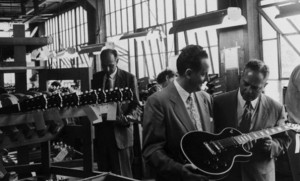
As with most things, this guitar is available at all different price points and quality levels. Today I’m taking a look at three Les Pauls, at three different price points. First up is this beautiful 2013 Gibson Les Paul Studio, at around $1100. Next is this gorgeous Epiphone Les Paul 1960 Tribute Plus, at around $600. And last is this Monoprice Route 66 imitation Les Paul, which can be had for a mere $100.
Let’s start at the bottom and work our way up.
Monoprice Route 66
I’ve been buying inexpensive cables at Monoprice for years, and when I saw that they now also carry guitars, I picked one up on sale for $99- total impulse buy! It’s their Route 66 model, in the vintage sunburst finish. It’s quite an attractive guitar and fairly well put together, but at around $100, they’ve obviously had to cut some corners. If I were building a parts guitar, I wouldn’t even be able to buy a reasonable neck for this price, let alone a full guitar.
This is clearly a Les Paul clone, but there are significant differences from a typical Les Paul. First, the woods- traditionally, the Les Paul has a mahogany body with maple cap, and a mahogany neck. This guitar has a solid basswood body with a maple neck and rosewood fretboard. The back and sides are painted black, so the only visible wood grain is on top- and it’s a nicely matched if somewhat uninteresting grain pattern. There’s no weight-relief in the body, and this guitar weighs in at 9.1 pounds.
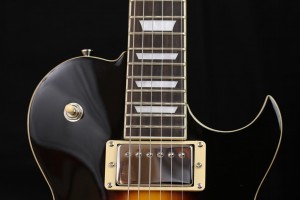
The neck is bolt on, which is typical for a cheap guitar, but the les Paul is known for its glued in set neck, which is one of the things that contributes to its famous long sustain. It’s a standard 24 3/4” scale length and 12” radius – 1.73” wide at the nut, and just under an inch thick. These dimensions are a close match with the USA Gibson 60s slim taper.
The truss rod works ok, but it’s not very smooth to adjust. The frets are rather rough and could use a polish, and there are a few high spots. Still, I think this would be a reasonable neck after a level crown and polish.
The components are serviceable but unsurprisingly at this price, not very high quality. The tuners are a bit inconsistent- some stiffer than others- but they appear to hold their tuning ok. The nut is plastic and not quite perfect – it’s a little too narrow for the neck, leaving some rough edges, and the strings are sitting too deep in the slots.
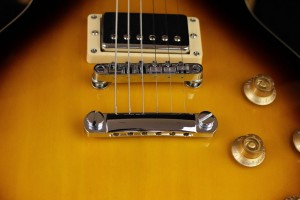
The humbuckers seem reasonable and definitely have a traditional Les Paul sound.
The knobs are laid out differently from a standard Les Paul, with the group rotated a bit. And the two volumes are on top and two tones on bottom, instead of neck volume and tone on top, and bridge volume and tone on bottom.
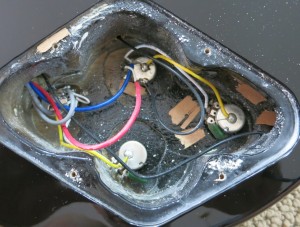
This guitar comes with a very lightweight gig bag. It’s only really sufficient to protect the guitar from scratches- I certainly wouldn’t trust it to protect the guitar on the way to a gig.
The overall quality on these guitars is a bit hit or miss. I’ve tried a few Route 66’s, and each has had its issues. This one has an extremely stiff tuner on the high E, and the bad 3-way switch. Monoprice has a generous return policy, so you can exchange as necessary. Of course, if you’re willing to invest some time and money, it shouldn’t be too difficult to change out and upgrade the components.
Overall, at this price, it seems like a reasonable starting point for a project guitar.
Epiphone Les Paul 1960 Tribute Plus
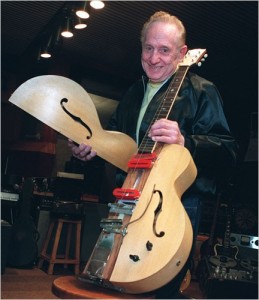
These days the Epiphone brand is owned by Gibson, and the guitars are manufactured in a Gibson-owned factory in Qingdao, China.
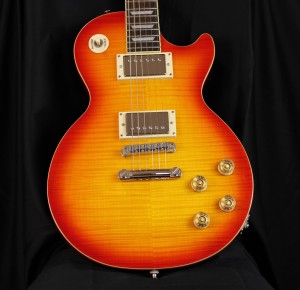
The body is made of three pieces of edge-glued mahogany, with a carved maple cap, and a vibrant AAA flamed maple veneer on top of that. The finish is a glossy polyurethane which is tough and durable. There’s no weight-relief here, and this guitar weighs in at around 9.2 pounds.
The neck is mahogany with a rosewood fretboard, and is attached to the body with a deep-set mortise and tenon joint. The nut is imitation bone- as in plastic- but it’s reasonably well-cut. The truss rod works quite well and the neck is easy to adjust. The neck shape is Epiphone’s 60’s slim taper, 1.7” wide at the nut, and just under an inch thick- with a 12” radius. Surprisingly, the frets arrived polished. I had previously played another 1960 Tribute Plus which had rather rough frets, so I guess I got lucky. There were however a couple high frets that needed some leveling.
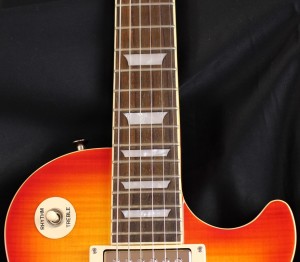
Unfortunately, the inlay work in the fretboard is a bit sloppy, with oversized slots for the trapezoids and some black filler around the edges. This doesn’t affect playability of course, but it doesn’t look so nice.
The tuners are the outstanding Grover locking rotomatics. They are smooth, and solid as a rock.
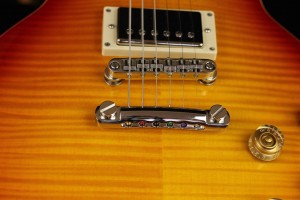
The knobs are the standard Les Paul configuration- neck volume and tone on top and bridge volume and tone on bottom. Additionally, the tone knobs are push-pull, and switch between series and parallel on the hum buckers. There’s a 57 Classic neck pickup and 57 classic plus in the bridge position- these sound very rich and dynamic. They’re worth a few hundred dollars on their own- so they add fantastic value to this guitar.
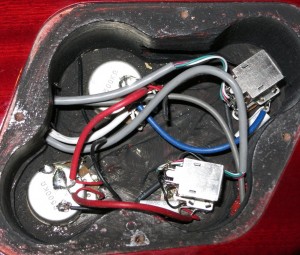
The 1960 Tribute Plus comes with an Epiphone hard case. It’s solid and will protect your guitar, but the surface coating is prone to tearing and peeling. Nothing a little black duct tape can’t solve.
This has been my go-to guitar for the last couple years – it’s versatile, roadworthy, and sounds great.
Gibson 2013 Les Paul Studio
This is a 2013 Gibson Les Paul Studio with a vintage Sunburst finish- made in the Gibson plant in Nashville Tennessee.
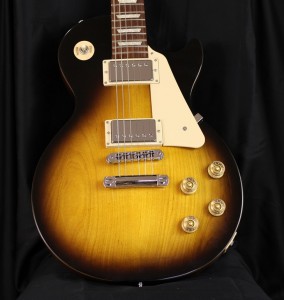
The body is two-piece mahogany, with a carved maple cap. The top has a nice flowing grain pattern and the book match is quite seamless. I don’t really miss the bindings- the contrasting woods and rich coloring have a nice visual appeal.
This body is routed with Gibson’s modern weight relief pattern- which reduces the guitar’s weight and adds resonance – this one weighs in at just under 8 1/2 pounds.
The finish is a traditional glossy nitrocellulose lacquer – this is a more labor intensive finish and supposedly allows the wood to resonate more freely than a thick poly finish. And it’ll age more gracefully, like a vintage guitar with some yellowing and possibly some cracking over the years.
The neck is a single piece of quarter sawn mahogany, carved in the the 60’s SlimTaper profile – with the standard 24 3/4″scale, 1.73” wide at the nut, and just under an inch thick, and 12″ radius. It’s a set-neck with a mortise and tenon joint. The nut is Corian – a type of very dense plastic that is supposed to be similar to bone, and is cut on the PLEK machine for ultimate accuracy. The truss rod feels super smooth when adjusting, and works perfectly.
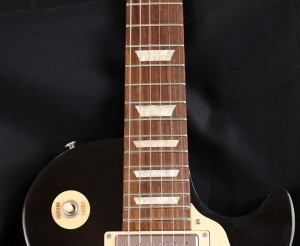
The trapezoid mother-of-pearl inlays are perfectly cut, and have nice vibrant coloring, The frets are perfect, even and polished.
The Kluson deluxe tuners are solid and smooth, and have a vintage vibe about them. The bridge is the Nashville Tune-o-matic – a very nice bridge with no retainer wire, and extended throw for easy intonation.
The knobs are of course in standard Les Paul configuration- neck volume and tone on top and bridge volume and tone on bottom. Additionally, the volume knobs are push-pull, with coil-splitting in the pulled position for single-coil sounds. They are reverse wound so the single coils are hum-cancelling in the middle position. There’s a 490R humbucker in the neck position and a 498T humbucker in the bridge. These have a little more presence in the mids compared to the 57 Classics.
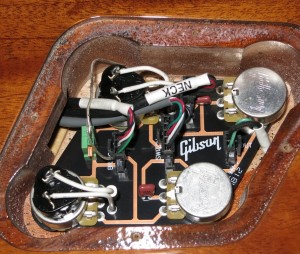
The heavy duty 3-way switch only takes a very light touch to switch.
The 2013 Les Paul studio comes with a Gibson hard case, made in Canada. It’s an excellent heavy duty case, and the inside smells strangely delicious too! I’m not kidding.
This is my brand new guitar. I think it’s an incremental step up from the Epiphone. It sounds very similar to the Epi Tribute Plus, but feels a bit nicer in the hands, and at nearly 1 pound less, it certainly should be easier on the shoulder and back during long rehearsals and gigs…
Recording Setup
I’m playing through my Vox AC15 handwired, with the cabinet mic’d just off center with a Sennheiser e609.
The guitar is plugged into the high gain input of the normal channel, with the bright switch engaged, and the channel volume at about a third. The master volume is around a quarter, with no tone cut.
I’ll start playing clean, and then kick on my Vox Ice 9 overdrive. I’ll try to play the same riffs on each guitar, always with the pickup volume and tone up full, and I won’t touch any of the amp or pedal settings between recordings.

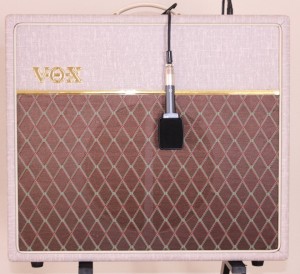
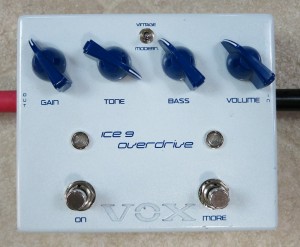
July 21, 2014 @ 1:00 pm
yesterday. It smells like cookies and cream!
July 21, 2014 @ 1:01 pm
July 21, 2014 @ 1:02 pm
July 21, 2014 @ 1:12 pm
to the standard, it just feels nicer
July 21, 2014 @ 3:46 pm
😀
July 21, 2014 @ 4:51 pm
July 22, 2014 @ 1:54 am
July 22, 2014 @ 2:44 am
a real Les Paul with the basswood body, bolt on neck and no maple cap. It’s
a rather a very cheap guitar made look like a Les Paul.
December 16, 2019 @ 12:26 pm
That was a good critique.
I just bought a Rt 66 LP on Letgo for 50.00….I don’t believe it was ever played. Spent the weekend going over it.
Tuners were upper end of low grade. They hold well with a refined smooth nut. (I’ve seen worse on eppy’s…those trapazoid tuners they use are a crime) I still think I may replace them eventually.
Intonation was way off. I got all but the thin E and D string dead on by moving the saddles up the the front edge of the bridge. Never saw a guitar intonation so flat….usually they’re sharp. The thin E took a little tuning on the nut (sloping the nut slot back behind the front edge)…you can compensate the intonation with the nut. I got close with the D string….it’s about 6 cents off. I could fix it dead on with a blank bone nut that’s square….I can take the leading edge further back. It’s close enough that not many people can hear it….a little vibrato at the 15 fret solves it….especially with the pretty jumbo frets.
I had to hammer down about 10 frets to get them reseated. Then I glued them all in place. That party is over. Lots of high frets. I have a 1 x 1″ x 5″ piece of trued rosewood sanding bar. Used it to bring the bad frets down to close and then got out the sanding beam. Didn’t take too long to get it level.
Recrowned with a file. Was left with about .042 high frets after the level. It was nice of them to start with pretty high frets. They left me with some fret meat after I cleaned up their mess.
Same problem with the three way….it’s a 1.00 chinese switch. Sprayed it with contact cleaner and it works but very stiff and chunky. I soldiered a .047 cap in series with the neck hot wire going to the 3 way…..a seymour duncan trick to clean up a muddy pickup….it did alright….gives the middle position a sliver of out of phase which may be how Seymour decided it cuts through better.
Added a chinese gibson 498T clone for 14.00. It’s a fine bridge pickup for the price…and wax potted. (14k, alnico 5….aliexpress.com or ebbay) He was dead on in his critique. The original pick ups are very vintage…they measure 9.5k which is a little hot….the vintage are usually 8k
The neck is okay for me….the bridge needed more bite.
Had to shim the neck pocket on the sides…it was very sloppy. Used some spanish ceder from a cigar box….they use it to separate the cigars….it’s a good hardwood and only .010 thick. It’s nice and tight now.
The pot knobs are the cheapest I’ve ever seen….a sliver over hard brittle paper. I can get more decent ones for 3.00 or so dollars on aliexpress.com.
I shielded the main pot cavity. Quieted down the guitar a lot.
I got about 65.00 in it and if I replace the tuners and the 3 way it would go head to head with a 700.00 Epiphone LP…I also put in a new jack….those chines3 jacks have metal as soft as butter. That cost me about 3.00…had an old radio shack jack. Actually it’s better that what most guitars have from the factory.
I’d like to find a cheap brass roller bridge that fits it…one of those 14.00 ones from china. It would be nice to have a little more adjustment for intonation and get rid of those bridge/saddle springs. It’s a pain having to fine tune the intonation with the nut.
I’m actually pretty happy how it turned out. The bridge was the only major problem….they must have been drinking when they measure for the studs. They got it way off but it’s workable. Beautiful Gold top by the way!
December 16, 2019 @ 2:42 pm
Hey David- Nice work- sounds like quite a project! Enjoy!
-John
July 22, 2014 @ 2:10 pm
side by side.
July 22, 2014 @ 9:37 am
“but the les Paul is known for its glued in set neck, which is one of the things that contributes to its famous long sustain.”
That’s debatable. I’ve built set-necks, bolt-ons, and neck-throughs, and they all sustain the same, assuming all other factors don’t change. The LPs sustain is more a product of the mass of he body. The heavier body absorbs less energy from the strings, and that results in longer sustain.
People often talk about imaginary boundaries, like glue lines and such as preventing the wood from vibrating, or transferring vibrations from one part to the next.
But you don’t want the wood to vibrate much, or transfer energy from the strings! If you do, you end up with an instrument that is loud acoustically. And acoustic instruments do not have as much sustain as solid bodies for this reason.
Taken to the extreme, we have a banjo; Almost 100% of the string’s energy is transferred to the head, and converted to acoustic vibrations (and probably heat). You end up with a loud tone with almost zero sustain.
Some other common myths are that a thin layer of finish will alter the tone of a solid body, and that tone caps affect the tone when the tone pot is on 10. 🙂
July 22, 2014 @ 9:45 am
Hi David,
Thanks for the informative comment. I’ve always *assumed* that the set neck improved sustain but with no real way to test it myself. Nice to have a datapoint from a guitar builder who is able to share some empirical evidence.
On the last point, the tone circuit can affect tone even when the pot is on 10, because it loads the pickup via the cap to ground. I found in my listening tests that a no-load pot or tone-bypass switch does indeed give a subtle bump in brightness, when bypassing the tone circuit.
-John
July 23, 2014 @ 6:07 pm
Bolt ons and set necks do sometimes sound different. I don’t think anyone has figured out why yet.
Regarding the tone cap; when the pot is on 10, the cap is effectively out of the circuit, but the resistance of the pot is not. As you turn down the tone control pot from ten, the major effect is changing the resistive loading on the resonant circuit.
This is because the impedance of the capacitor in the range of the resonance is a lot less than the pot value. As the pot gets closer to zero, the capacitor becomes important, but the initial effect is just resistive loading.
So it’s the resistance of the pot to ground you are hearing, more than the cap.
But the reason I mentioned this is because you see countless comments from people saying putting something paper in oil caps in their Les Paul changed the tone… even with the tone pot on 10. On top of the fact that they aren’t hearing the cap, any two caps with the same value, ceramic, polyester, paper-in-oil, will sound the same. There is no signal going through the cap that you can hear. The treble frequencies going through the cap are shunted to ground.
December 30, 2014 @ 8:47 am
David and John, Thank you for the great data points and discussion. I really appreciated the discussion on “what affects sustain”. My feeling is this…getting the “right sustain” (not necessarily the most or the longest) comes first from the guitar but there are also other factors that can affect it such as the amplifier and affects. I think we have all grown up and been influenced by some wonderful classical rock guitar work done with the classic Les Pauls and guitarists and guitar players have done lots to try and imitate that sound, in fact people have done so much to try and understand the sound that there are many mystical and magical theorys about the sounds of the past. As much as I want to believe in mystic and magic I have come to the conclusion that a great batch of guitars was produced and great players worked hard and produced great music from them, so in summary I think tone/sustain comes from first from the player, then the guitar and then the amp and affects. If you agree with that it is reasonable to conclude that the guitar can only take you so far and in the long run having a great guitar is nice but you really don’t need a great “guitar” you need a great player first and foremost. As an example I own a Hagstrom “Select Swede”, this guitar is so “hard and heavy” and no acoustic sounds are lost in its body, it also has individual tail pieces for each string amongst other things, I think they took the Les Paul hard/heavy idea to the extreme, so if hard/heavy were the what really made a guitar sustain perfectly this would be the perfect guitar. In summary I think its about about having the “right blend” of materials/construction and the good player knows how to adjust around it.
Today’s guitars (mid price and above) are amazingly well made and the foreign/domestic argument is really watered down and not as clear as it once was (way in the beginning when foreign guitar were terrible). Today’s foreign guitar utilze the same process as we use domestically, so it’s a more a matter of the parts and manufacturing process, not foreign VS domestic. Of course there is always the exception of really cheap guitars that are being sold at Walmart etc, those guitars will always be lower quality because they are meant for kids staring out, not for the dedicated players reading this article.
I have watched videos online of the domestic and foreign guitar plants and either way, guitars are “massed produced” in an assembly line utilizing modern tools that are more accurate and reliable than a human. That said, it is very important for a humans to runs the production line and that quality issues in the production line be controlled and understood ASAP, which I think many modern guitar factories do (foreign or domestic).
July 23, 2014 @ 5:45 pm
Nice video John!! But may I give my perpective about sustain and ressonance?
I tottaly agree with David.
Sustain is not directly dependent by set/glued vs. bolt-on neck. There are bolt-on guitars that sustain for days, as much (and in some cases even more) than a guitar with a set-neck. It’s mainly a matter of how good the bridge/saddle and nut are solidly connected to the body and neck of the guitar, the density of the material (be it wood or anything else) where they are attached.
Of course, the neck joint have to be solid also. set very tightly with a almost perfect contact, be it a glued or a bolt on neck. Even so we may ask what is better, a wood-glue-wood joint, or a wood-wood joint? 😉 food for thought….
There’s another couple of factors, a LP is a fixed bridge with humbuckers. These two factors will give you more sustain, one for the reason I said above, and the other because humbuckers have more “output” and, hence the longer decay of sound.
Ressonance, it’s very nice too strum and feel a ressonating guitar. But is it good? From my point of view, if a string is vibrating the last thing I want to happen is that vibrating energy to be passed away to anyother body. When the guitar is ressonating is the string passing it’s vibrating energy to it. Hence, lower sustain. Now if a guitar doesn’t ressonate, doesn’t vibrate at all, I bet the strummed string will sustain for decades.
Ok thuis is my point of view of things. I am not trying to be cocky. I hope this would start a nice debate.
July 23, 2014 @ 9:26 pm
David’s and your points all make sense. As an amateur woodworker as well (building furniture, not instruments), this stuff fascinates me. I’d love to have the tools and setup to do a proper comprehensive evaluation of the factors that affect sustain…
-John
July 23, 2014 @ 5:51 pm
Oh about the tone caps, yes… a “no-load” will not “load” the signal. I mean it will bypass whatever resistance to ground on that particular point os the circuit, being the low-pass filter. So, “no resistance”, no low-pass filter at all. Hence, more brightness on the sound.
July 26, 2014 @ 11:34 am
July 31, 2014 @ 5:56 am
question, is, was the Gibson worth the extra money over the Epiphone? Once
you had/have the Epiphone properly set up, is the Gibson that more
staisfying to play?
August 1, 2014 @ 9:17 am
Hi, John! Very nice video, very informative! I liked how you did the comparison (and now I won´t consider a Monoprice LP; there are better LP style guitars for some more money but with better hardware and features IMHO) I understand that your point is not to say “Don´t buy a Monoprice LP”, but rather to show what you´re getting. I would say that for someone who´s beginning to learn guitar is a good starting point, and then, if definitely interested in playing guitar, he/she can look for a better option; again, IMHO.
Interesting comments from David and Zedsnotdead as well.
John, many thanks again, I really enjoyed watching the video.
August 2, 2014 @ 7:22 am
Thanks Sabas!
-John
August 17, 2014 @ 7:23 am
taper and linear pots. which one is your preference for volume and tone
pot? which one is better for volume swelling in your opinion? cheers john
August 18, 2014 @ 10:28 pm
wanted to play… the second guitar with the cherry burst design looks good
but I want something for beginners… think its a good buy? Or should I get
another guitar?
September 10, 2014 @ 8:46 am
September 11, 2014 @ 11:31 pm
guitars. I’ve had a couple of Epi LPs over the years and though I’m a
Strat guy, your review makes me want to go shopping for a Gibbie Studio.
🙂
September 16, 2014 @ 8:29 pm
tought me a lot about guitars.
Thanks…
September 18, 2014 @ 10:12 am
less than a year and part of that time has been on a 12-string. So when a
friend lent me his Epiphone Les Paul, I found the slim taper neck to rather
small, even for my just-medium sized hands. The Tribute Plus has always
been the Epi LP I planned to buy, but I wish they’d offer the ’59 neck, as
they do on the John Bonamassa Tribute and the new Lee Malia Tribute.
Thoughts?
September 24, 2014 @ 9:49 am
of strings on each guitar?
September 30, 2014 @ 6:09 am
October 8, 2014 @ 12:45 am
i just find the overdrive is a little bit harsh to my ears..
October 14, 2014 @ 3:46 am
last few years — again, excellent sir. Having owned a standard I have
really come to appreciate the studios I have had privy of playing,
although, the Epiphone’s are looking more and more appealing these days.
Thx, rk
October 26, 2014 @ 8:34 am
videos. Great job and very in depth. Thanks. (I love my Epi 1960 Tribute
Plus)
November 10, 2014 @ 11:25 am
flow. I have seen epi’s blow gibson away too, its all in the luck of the
wood chosen and matched with good hardware. the epi standard plus tops are
also very good. But gibson is the bench mark of course. Would you say the
studio edges it over the other 2 in your opinion?.
November 10, 2014 @ 11:25 am
flow. I have seen epi’s blow gibson away too, its all in the luck of the
wood chosen and matched with good hardware. the epi standard plus tops are
also very good. But gibson is the bench mark of course. Would you say the
studio edges it over the other 2 in your opinion?.
December 3, 2014 @ 7:38 pm
you get paid not to play
December 11, 2014 @ 10:31 am
the Epiphone is an economy guitar, and the Chibson is low end garbage.
It’s amazing how many people will pay $300 for a $100 guitar if it the
Chinese seller is willing to put a Gibson logo on it.
December 15, 2014 @ 10:38 am
Really thorough review – thank you. I have a 2003 USA Gibson and a 2013
Epiphone PlusTop Pro. Both great guitars. I have to say that I play my
Epiphone most. Maybe I feel sorry for it as so many people are rude about
them without reason in my opinion. Binding, frets, inlays and pick ups are
excellent. It has the retaining wire on the bridge but mine doesn’t buzz
so no problem there. At £350 it is real value for money (and it has a
warranty which the fakes don’t have).
December 23, 2014 @ 6:52 am
December 24, 2014 @ 9:49 pm
Studio.
December 25, 2014 @ 4:25 pm
best to me overall and looks AWESOME!! I have the same exact 2013 Gibson
Les Paul Studio, which I bought as an upgrade to my Epiphone Les Paul
Standard and it was the best $1150 I ever spent for a guitar !..!
December 30, 2014 @ 11:33 am
regarding the pickup position!!
thank you for your response !! Keep it up !!
January 9, 2015 @ 8:43 pm
balls as the Gibbie.
January 11, 2015 @ 8:04 pm
January 11, 2015 @ 8:26 pm
January 11, 2015 @ 8:29 pm
January 20, 2015 @ 5:49 pm
January 20, 2015 @ 7:19 pm
January 20, 2015 @ 7:19 pm
January 22, 2015 @ 4:28 am
one that you have.. Thanks
January 25, 2015 @ 1:34 am
Major scale? Harmony? It’s not all about TONEZ people!!!
January 25, 2015 @ 11:17 am
queation?
thanks
keith
February 3, 2015 @ 5:10 pm
February 13, 2015 @ 12:29 am
Tribute Plus about a week ago, and the inlays are literally perfect, not a
single gap. They are Gibson quality, to be honest. Maybe it’s because of
it’s age, being a bit newer. I opted for the Vintage Burst, and for anyone
looking at the Epi, just pull the trigger. It is an absolutely fantastic
guitar. Plays just as well as a Standard after you replace the nut and
polish the frets a bit.
February 20, 2015 @ 4:24 pm
new Gibson LP smells wonderful. 🙂
February 22, 2015 @ 4:29 am
would like to ask you about the Epi Tribute plus…I ve seen that yours is
the classic Cherry burst colour…but so far from my seach i ve noticed
that its only available in Faded Cherry burst which has more orange than
Red…is that so??
March 20, 2015 @ 12:20 pm
Goldtop(burstbucker 2/3)neck tenon.Mallory 150, 500 pots,grover tuners, 59
baseball bat neck,no weight relief
and I have a 2013 Gibson LPJ(490R /498T) so versatile, Hard 4 me 2 decide,
which I like best. im in love with both pickup combos
the epi shreds all of my other axes , so much fat wooley mid range
Gibson is the bell, but the epiphone is the bell ringer. it must be the
burstbuckers
March 21, 2015 @ 7:54 pm
March 25, 2015 @ 1:41 am
new. Gibson have made a bit of a convert of me with this new basic model.
Think ill be looking at a standard down the track. your video is a great
comparison vid, nice to see something a little different.
April 8, 2015 @ 4:32 pm
April 12, 2015 @ 8:02 am
Epiphone tribute as well as a Gibson either LP Studio or Classic. Been on
the fence because I own an Epiphone Sheraton ii which I upgraded the
pickups, wiring and bride/tailpiece to Tonepros, but it still seems very
dark. My guess is its the the veneer finish. But your Epi sounds great! Any
thoughts? It seems like a great value for the $$$. I can easily afford the
Gibson, but dont want to just pay for the name.
April 14, 2015 @ 4:07 pm
appreciate the suggestion on the bridge replacement, though it’s great as
is. Will have a bone nut made for it but again, fine as is. Seriously, why
spend $3K on an LP Standard? I LOVE my Epi 1960 Tribute Plus. (The blue is
AWESOME).
April 27, 2015 @ 3:52 pm
May 1, 2015 @ 5:57 pm
May 8, 2015 @ 5:36 pm
May 9, 2015 @ 4:46 pm
of spending 3K more on the same guitar whose only difference is the fact
that it’s inlays are imperfect by a millimeter. If you have that kind of
money to spend, more power to you. If i had a several million dollar record
deal I’d buy tons of Gibsons, too. But until then, I’ll continue to buy the
incredible Epiphone.
May 18, 2015 @ 11:32 am
fretboard.It’s mainly cos of the pickups that it sounds so good.It is great
quality.But a Gibson is a whole different type of magic for the extra cash.
May 22, 2015 @ 6:10 pm
learned / can’t wait to view all your’ work.
May 23, 2015 @ 5:00 pm
player 80% of the sound, amp 15% guitar 5%
if you want to waste money on gibsons for sound alone its up to you.
but they are investments you can always sell on.
May 24, 2015 @ 12:29 am
June 1, 2015 @ 5:35 am
June 4, 2015 @ 2:29 am
together…
June 12, 2015 @ 4:57 pm
June 21, 2015 @ 7:22 pm
Tribute Plus? Thanks
June 23, 2015 @ 7:04 am
July 10, 2015 @ 7:59 am
July 13, 2015 @ 6:22 am
July 20, 2015 @ 7:26 am
Pro and a Florentine, and they are just incredible. I may sell the Custom
Pro to get a Tribute Plus, mostly for the Classic ’57s.
July 26, 2015 @ 5:37 pm
July 29, 2015 @ 8:49 pm
it’s crazy to eventually do a fret job. Might as well get a new guitar. So
that is what I did. I now have a number of Monoprice guitars and am
satisfied with all of them. I continually rotate the use of them so as to
put as little fret wear on each one.
Get a Gibson Les Paul for over $1,000.00 or get about 9 Monoprice guitars
for about the same price. The choice is yours. I choose having multiple
Monoprice guitars. They all look and sound great!
Three Les Pauls Video Shoot – Behind The Scenes - Planet Z
March 28, 2017 @ 10:05 am
[…] was just looking through some old photos and came across these, taken during my shoot for my Three Les Pauls video. I was really happy with how that video turned out. I’ve been asked a few times how I […]
2013 Gibson SG “Future Tribute” - Planet Z
March 29, 2017 @ 3:32 pm
[…] I love both my Les Paul’s, they’re really heavy – over 9 pounds – which gets a little tiresome during long rehearsals […]
August 17, 2021 @ 8:26 pm
Things that come to mind while reading these comments; How many of these individuals have compromised hearing? How many of these individuals are parroting what they read on marketing blogs and forums? Are these individuals posting out of boredom, to be part of the herd, or impress someone?
There is a right way and a wrong way to do everything, hence the concept of due diligence, be it investing time and discipline into becoming a competent musician or bothering to spell check. Lastly, People will justify spending their money on absolutely anything.
Apparently, Duane Allman, Billy Gibbons, and Jimmy Page just weren’t up to the standards of all the genius posting here.